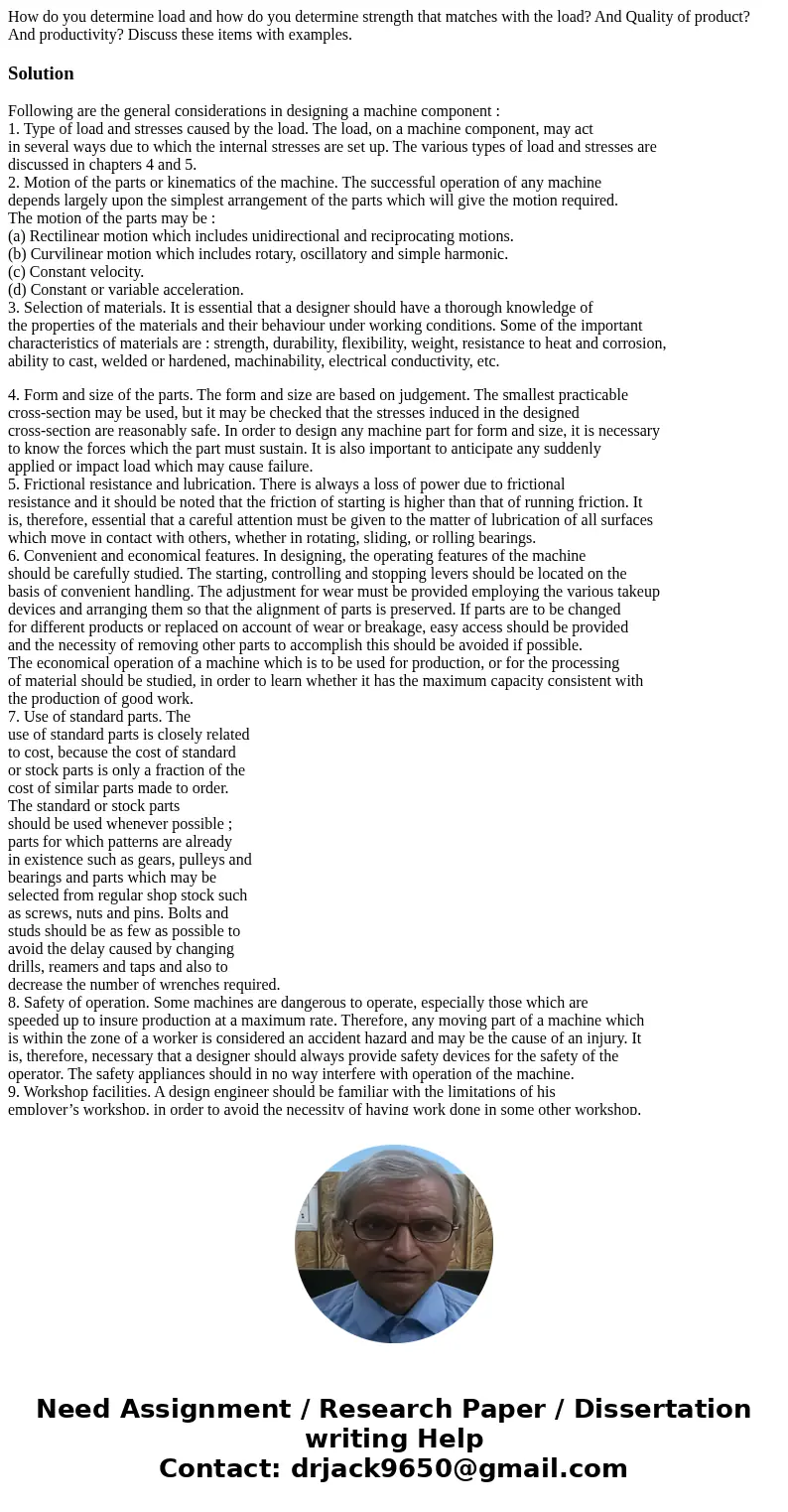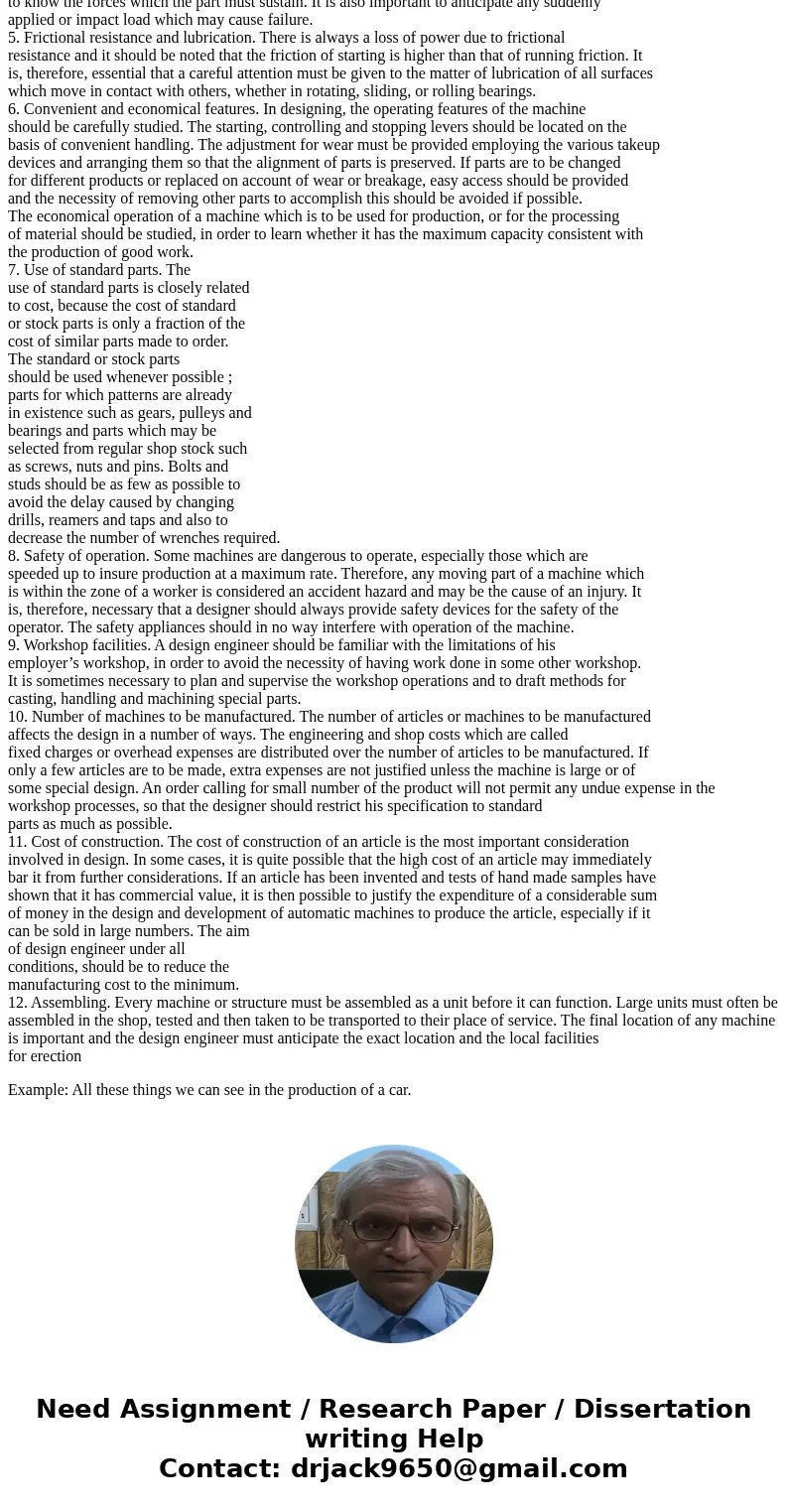How do you determine load and how do you determine strength
How do you determine load and how do you determine strength that matches with the load? And Quality of product? And productivity? Discuss these items with examples.
Solution
Following are the general considerations in designing a machine component :
1. Type of load and stresses caused by the load. The load, on a machine component, may act
in several ways due to which the internal stresses are set up. The various types of load and stresses are
discussed in chapters 4 and 5.
2. Motion of the parts or kinematics of the machine. The successful operation of any machine
depends largely upon the simplest arrangement of the parts which will give the motion required.
The motion of the parts may be :
(a) Rectilinear motion which includes unidirectional and reciprocating motions.
(b) Curvilinear motion which includes rotary, oscillatory and simple harmonic.
(c) Constant velocity.
(d) Constant or variable acceleration.
3. Selection of materials. It is essential that a designer should have a thorough knowledge of
the properties of the materials and their behaviour under working conditions. Some of the important
characteristics of materials are : strength, durability, flexibility, weight, resistance to heat and corrosion,
ability to cast, welded or hardened, machinability, electrical conductivity, etc.
4. Form and size of the parts. The form and size are based on judgement. The smallest practicable
cross-section may be used, but it may be checked that the stresses induced in the designed
cross-section are reasonably safe. In order to design any machine part for form and size, it is necessary
to know the forces which the part must sustain. It is also important to anticipate any suddenly
applied or impact load which may cause failure.
5. Frictional resistance and lubrication. There is always a loss of power due to frictional
resistance and it should be noted that the friction of starting is higher than that of running friction. It
is, therefore, essential that a careful attention must be given to the matter of lubrication of all surfaces
which move in contact with others, whether in rotating, sliding, or rolling bearings.
6. Convenient and economical features. In designing, the operating features of the machine
should be carefully studied. The starting, controlling and stopping levers should be located on the
basis of convenient handling. The adjustment for wear must be provided employing the various takeup
devices and arranging them so that the alignment of parts is preserved. If parts are to be changed
for different products or replaced on account of wear or breakage, easy access should be provided
and the necessity of removing other parts to accomplish this should be avoided if possible.
The economical operation of a machine which is to be used for production, or for the processing
of material should be studied, in order to learn whether it has the maximum capacity consistent with
the production of good work.
7. Use of standard parts. The
use of standard parts is closely related
to cost, because the cost of standard
or stock parts is only a fraction of the
cost of similar parts made to order.
The standard or stock parts
should be used whenever possible ;
parts for which patterns are already
in existence such as gears, pulleys and
bearings and parts which may be
selected from regular shop stock such
as screws, nuts and pins. Bolts and
studs should be as few as possible to
avoid the delay caused by changing
drills, reamers and taps and also to
decrease the number of wrenches required.
8. Safety of operation. Some machines are dangerous to operate, especially those which are
speeded up to insure production at a maximum rate. Therefore, any moving part of a machine which
is within the zone of a worker is considered an accident hazard and may be the cause of an injury. It
is, therefore, necessary that a designer should always provide safety devices for the safety of the
operator. The safety appliances should in no way interfere with operation of the machine.
9. Workshop facilities. A design engineer should be familiar with the limitations of his
employer’s workshop, in order to avoid the necessity of having work done in some other workshop.
It is sometimes necessary to plan and supervise the workshop operations and to draft methods for
casting, handling and machining special parts.
10. Number of machines to be manufactured. The number of articles or machines to be manufactured
affects the design in a number of ways. The engineering and shop costs which are called
fixed charges or overhead expenses are distributed over the number of articles to be manufactured. If
only a few articles are to be made, extra expenses are not justified unless the machine is large or of
some special design. An order calling for small number of the product will not permit any undue expense in the workshop processes, so that the designer should restrict his specification to standard
parts as much as possible.
11. Cost of construction. The cost of construction of an article is the most important consideration
involved in design. In some cases, it is quite possible that the high cost of an article may immediately
bar it from further considerations. If an article has been invented and tests of hand made samples have
shown that it has commercial value, it is then possible to justify the expenditure of a considerable sum
of money in the design and development of automatic machines to produce the article, especially if it
can be sold in large numbers. The aim
of design engineer under all
conditions, should be to reduce the
manufacturing cost to the minimum.
12. Assembling. Every machine or structure must be assembled as a unit before it can function. Large units must often be assembled in the shop, tested and then taken to be transported to their place of service. The final location of any machine is important and the design engineer must anticipate the exact location and the local facilities
for erection
Example: All these things we can see in the production of a car.


 Homework Sourse
Homework Sourse